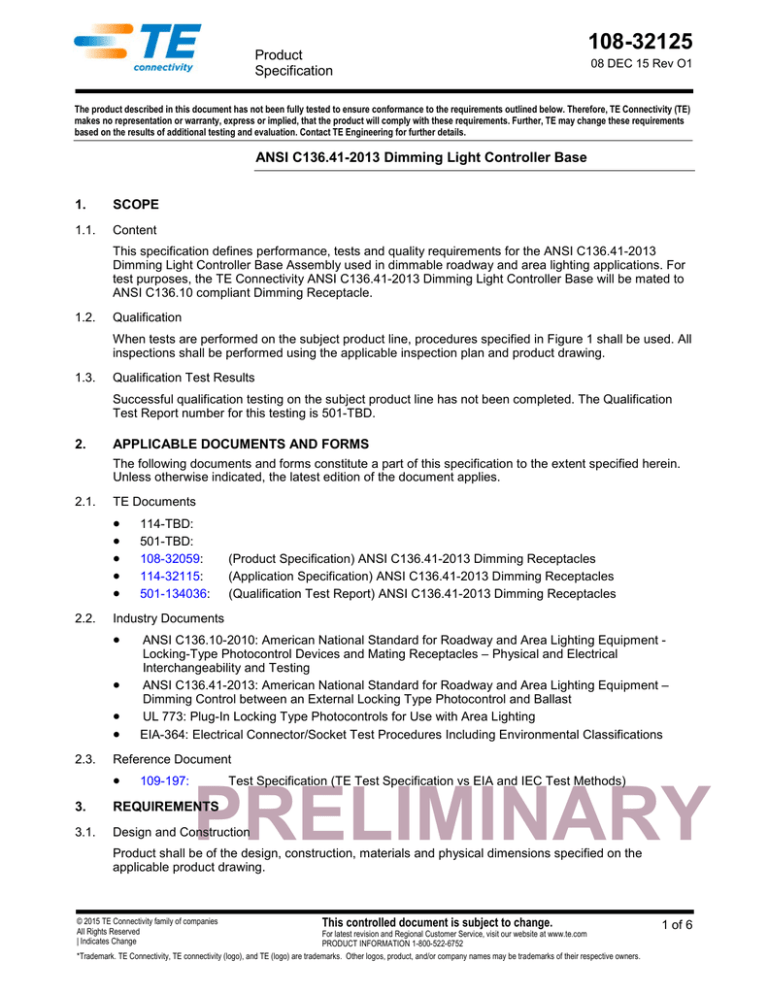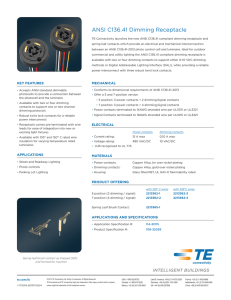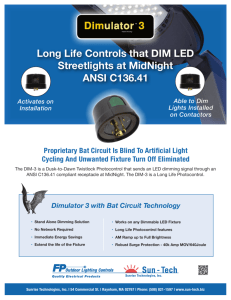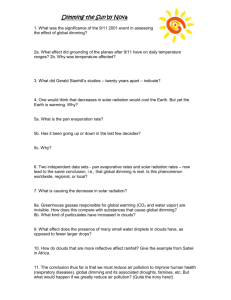
Product
Specification
108-32125
08 DEC 15 Rev O1
The product described in this document has not been fully tested to ensure conformance to the requirements outlined below. Therefore, TE Connectivity (TE)
makes no representation or warranty, express or implied, that the product will comply with these requirements. Further, TE may change these requirements
based on the results of additional testing and evaluation. Contact TE Engineering for further details.
ANSI C136.41-2013 Dimming Light Controller Base
1.
SCOPE
1.1.
Content
This specification defines performance, tests and quality requirements for the ANSI C136.41-2013
Dimming Light Controller Base Assembly used in dimmable roadway and area lighting applications. For
test purposes, the TE Connectivity ANSI C136.41-2013 Dimming Light Controller Base will be mated to
ANSI C136.10 compliant Dimming Receptacle.
1.2.
Qualification
When tests are performed on the subject product line, procedures specified in Figure 1 shall be used. All
inspections shall be performed using the applicable inspection plan and product drawing.
1.3.
Qualification Test Results
Successful qualification testing on the subject product line has not been completed. The Qualification
Test Report number for this testing is 501-TBD.
2.
APPLICABLE DOCUMENTS AND FORMS
The following documents and forms constitute a part of this specification to the extent specified herein.
Unless otherwise indicated, the latest edition of the document applies.
2.1.
TE Documents
•
•
•
•
•
2.2.
(Product Specification) ANSI C136.41-2013 Dimming Receptacles
(Application Specification) ANSI C136.41-2013 Dimming Receptacles
(Qualification Test Report) ANSI C136.41-2013 Dimming Receptacles
Industry Documents
•
•
•
•
2.3.
114-TBD:
501-TBD:
108-32059:
114-32115:
501-134036:
ANSI C136.10-2010: American National Standard for Roadway and Area Lighting Equipment Locking-Type Photocontrol Devices and Mating Receptacles – Physical and Electrical
Interchangeability and Testing
ANSI C136.41-2013: American National Standard for Roadway and Area Lighting Equipment –
Dimming Control between an External Locking Type Photocontrol and Ballast
UL 773: Plug-In Locking Type Photocontrols for Use with Area Lighting
EIA-364: Electrical Connector/Socket Test Procedures Including Environmental Classifications
Reference Document
•
109-197:
Test Specification (TE Test Specification vs EIA and IEC Test Methods)
PRELIMINARY
3.
REQUIREMENTS
3.1.
Design and Construction
Product shall be of the design, construction, materials and physical dimensions specified on the
applicable product drawing.
© 2015 TE Connectivity family of companies
All Rights Reserved
| Indicates Change
This controlled document is subject to change.
For latest revision and Regional Customer Service, visit our website at www.te.com
PRODUCT INFORMATION 1-800-522-6752
*Trademark. TE Connectivity, TE connectivity (logo), and TE (logo) are trademarks. Other logos, product, and/or company names may be trademarks of their respective owners.
1 of 6
108-32125
3.2.
Ratings
•
•
•
•
•
3.3.
Power Contact Voltage: 600 volts AC/DC
Power Contact Current: 15 amperes maximum per circuit at 25ºC ambient temperature
Signal Dimming Contact Voltage: 30 volts DC
Signal Dimming Contact Current: 1.5 amperes maximum per circuit at 25ºC ambient temperature
Operating Temperature: -40 to +85ºC
Test Requirements and Procedures Summary
Unless otherwise specified, all tests shall be performed at ambient environmental conditions.
Test Description
Requirement
Procedure
Initial examination of product.
Meets requirements of product
drawing and Application
Specification
EIA-364-18.
Visual and dimensional (C of C)
inspection per product drawing.
Final examination of product.
Meets visual requirements.
EIA-364-18.
Visual inspection.
Low Level Contact Resistance
(LLCR).
Insulation resistance.
Dielectric Withstanding Voltage
Current Cycling(Heating Test),
Power Contacts Only
Temperature Rise vs Current
Rev O1
ELECTRICAL
ΔR of 30 milliohms maximum
EIA-364-23.
Subject mated receptacle and Light
Controller to 20 millivolts open
circuit at 100 milliamperes
maximum.
See Figure 3 and 4.
500 megohms minimum.
EIA-364-21.
Test unmated Light Controller Base
only.
Test between adjacent power
contacts; between power and signal
contacts; and between all contacts
and grounded mounting plate.
One minute hold with no breakdown UL 773, Section 32
or flashover.
2500 volts AC (rms) at sea level.
Test unmated Light Controller Base
only.
Test between power contacts;
between signal contacts; between
power and signal contacts; and
between power contacts and
grounded mounting plate.
30ºC T-rise maximum during the
ANSI C136.10-2010, Section 11.1.
“ON” period of the cycle.
Apply 15 amperes to line and load
contacts of Light Controller Base
and test receptacle for 15 cycles,
each consisting of 20 hours “ON”
and 4 hours “OFF”. Precondition
Light Controller by mating and
unmating to a receptacle 5 times.
30ºC maximum temperature rise at EIA-364-70, Method 1
15.0 amperes for power contacts
Stabilize at a single current level
and 1.5 amperes for signal dimming until 3 readings at 5 minute intervals
contacts.
are within 1ºC. Power line & load
(but not neutral) circuits and all
dimming signal contact shall be
energized and monitored during
testing.
2 of 6
108-32125
Test Description
Power Blade Contact Retention in
Housing Base
Vibration
Mechanical shock.
Durability.
Salt Spray
Thermal shock.
Humidity
Rev O1
Requirement
Procedure
MECHANICAL
15.0 lbs. minimum
EIA-364-29B
Apply force by pushing in the
direction of the mating face at a rate
of 25.4mm/min. on power contact
solder tails.
No discontinuities of 1 microsecond The specimens shall be subjected
or longer duration.
to a simple harmonic motion having
See Note (a).
an amplitude of either 0.250 in
double amplitude (maximum total
excursion) or 3.5 g peak, whichever
is less. The vibration frequency
shall be varied logarithmically
between the approximate limits of 5
Hz and 55 Hz. The entire frequency
range of 5 Hz to 55 Hz and return to
5 Hz shall be traversed at a rate of
one octave/minute. This cycle shall
be repeated for one hour in each of
three mutually perpendicular
directions, so that the motion shall
be applied for a total period of 3
hours. Lead wires shall be secured
to vibration table 6 inches from rear
of connector. See Figure 5.
No discontinuities of 1 microsecond EIA-364-27, Condition H.
or longer duration.
Subject mated specimens to 30 G's
See Note (a).
half-sine shock pulses of 11
milliseconds duration. Three shocks
in each direction applied along 3
mutually perpendicular planes, 18
total shocks.
See Figure 5.
See Note (a)
EIA-364-9.
Subject Light Controller Base and
receptacle to 25 mating and
unmating cycles at the rate of 120
cycles per hour.
ENVIRONMENTAL
See Note.
IEC 60512-11-6
Exposure time is 240 hours. Test
receptacle mated to a shorting cap.
See Note.
EIA-364-32, Test Condition I.
Subject unmated specimens to 25
cycles between -40 and 65°C with
30 minute dwells at temperature
extremes and 1 minute transition
between temperatures.
Must be subjected to DWV within 10 UL 773, Section 23.
minutes from removal of humidity
Subject mated Light Controller Base
test chamber.
and receptacle to 96% noncondensing humidity for 168 hours
at a temperature of 50ºC.
3 of 6
108-32125
Test Description
Temperature life.
Shelf Aging
Immersion Protection
Pressure Test
Requirement
Procedure
See Note.
EIA-364-17, Method A, Test
Condition 4, Test Time Condition B.
Subject mated specimens to 100°C
for 500 hours.
Conditioning only - Must meet
Subject Light Controller base with
subsequent test requirements
cap installed to 65+/-3⁰ for 240 hrs.
Must meet IP66
IEC 60259. Subject Light Controller
Base only with cover installed to the
IP66(water spray) requirements.
Light Controller assembly with cover Subject Light Controller Base with
installed must hold 80% of specified cover installed to an internal
pressure for 5 minutes.
atmospheric pressure of 25 psi.
NOTE
Shall meet visual requirements, show no physical damage, and meet requirements of additional
tests as specified in the Product Qualification and Requalification Test Sequence shown in
Figure 2.
Figure 1 end
3.4.
Product Qualification and Requalification Test Sequence
1
Test or Examination
Initial examination of product
LLCR
Insulation resistance
Dielectric withstanding voltage
Current Cycling (Heating Test)
Temperature Rise vs. Current
Power Contact retention in housing base
Vibration
Mechanical shock
Durability
Salt Spray
Thermal shock
Humidity
Temperature life
Shelf Aging
Immersion Protection
Pressure Test
Final examination of product
NOTE
1
2,6
Test Group (a)
3
4
5
Test Sequence (b)
1
1
1
1
2,5,7,9
2,4
2,7
3,6
2(c)
3,10
2
6
7
8
1
1
1
2
4
5
3
8(d)
3
4(c)
6
4
5
2
3
7
11
8
5
3
3
4
2
3
(a) Specimens shall be prepared in accordance with applicable Instruction Sheets and shall be
selected at random from current production. Test groups 1, 2, & 3 shall consist of a
minimum of ten ANSI C136.41-2013 Light Controller Bases and Receptacles. Test groups
4 through 6 consist of a minimum of three ANSI C136.41-2013 Light Controller Bases and
Receptacles.
(b) Numbers indicate sequence in which tests are performed.
(c) Precondition with 5 durability cycles.
(d) During vibration, the mated receptacle and shorting cap shall be energized at an 18°C
temperature rise level and 100% connector current loading.
Figure 2 end
Rev O1
4 of 6
108-32125
Figure 3
(LLCR Measurement Points – Power Contacts)
Figure 4
(LLCR Measurement Points – Signal Dimming Contacts)
(Receptacle housing removed for clarity.)
Rev O1
5 of 6
108-32125
Figure 5
(Vibration and Mechanical Shock Mounting Fixture)
Rev O1
6 of 6





